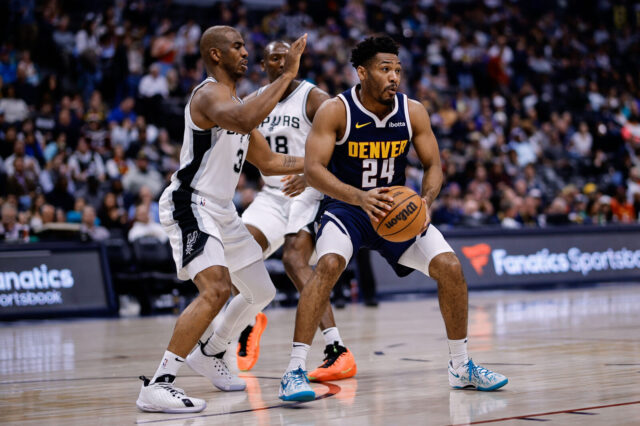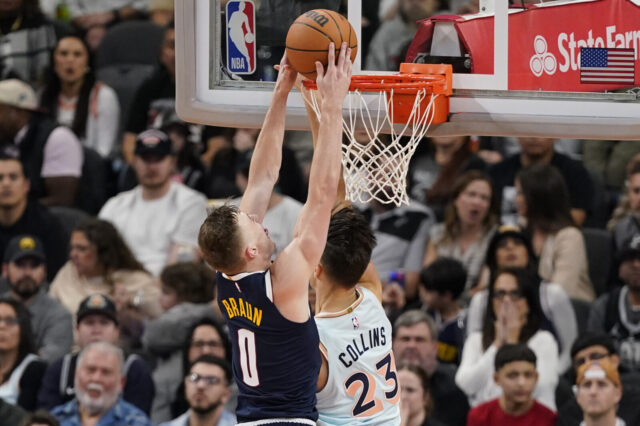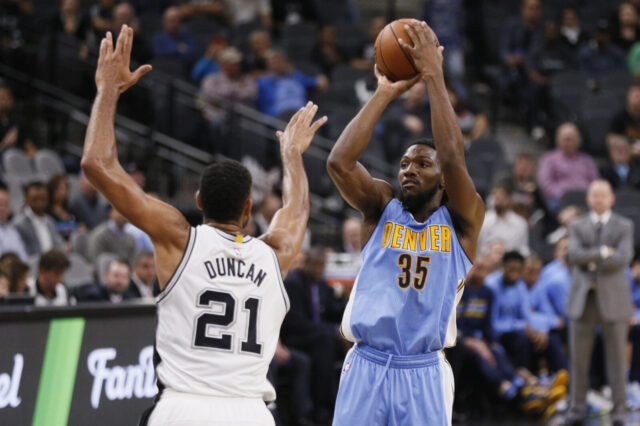From a physical perspective, Malik Beasley looks like an ideal shooting guard in the NBA. He’s in peak physical condition, able to elevate high above the rim and explode down the court in transition. He has a jump shot that looks like it should be projected on a screen, or however we watch film in the future, when we want to remember what basketball looked like back in the good old days before the 5-point line.
For the talented third-year wing, the physical part of the game has never been an issue for him while he’s been in Denver. The mental aspect of the game, however, has kept him from breaking into the rotation. Our Chief Big Stiff, Adam Mares, often talks about how Beasley needs to simplify his game in order to earn more minutes in the rotation.
It has been difficult for Beasley to come to terms with his ambitions (starting shooting guard) and his role (backup shooting guard). The challenge of going from a top 100 recruit in high school to a top option as a freshman for a Division I program to a backup with limited minutes and shot attempts is a difficult challenge for a lot of players. The problem was compounded by the coaching staff making him the focal point on offense in Summer League — how are you going to ask him to go from leading the offense in Las Vegas to taking a couple 3-pointers per game in Denver?
This season, however, it seems like the message from the coaching staff to quit trying to do too much, to make the simple play, has finally started to sink in. Beasley is averaging career bests across the board, and he’s getting more playing time because he’s sticking to the things the coaching staff feels is most important for him — defense, 3-point shooting, rebounding, and not turning the ball over. When he’s able to do those things, he’s at his best.
Nuggets fans were able to see what his best was on Monday night against the New Orleans Pelicans. With Torrey Craig continuing to struggle to do anything of value on offense, Beasley played a career-high 31 minutes, scoring 12 points and grabbing six rebounds.
It was great for Nuggets fans to see the fruition of what they’ve long hoped for — he was knocking down jumpers, dunking, and playing good defense.
After the game, Malone was asked if he was considering any changes to his starting lineup, perhaps with the idea that Beasley has earned a bigger role.
After the game, Beasley spoke to Harrison Wind of BSN Denver, telling him, “Right now I’m behind Gary Harris. He’s always making me better every day. I’m a starting shooting guard who happens to play off the bench. That’s how I see it.”
With Harris entrenched as the starter, and under contract for the next three seasons, it is unlikely that Beasley will ever be listed as the starting shooting guard on the Nuggets roster. This isn’t an insult to Beasley — Harris is just a better player than he is.
But that doesn’t mean that Beasley can’t be the fifth starter on the Nuggets — right now.
After Will Barton went down with a groin injury, Torrey Craig was tabbed as the replacement. The former two-way player has earned the respect of the coaching staff with his hustle and defense, but his 3-point shooting (14 percent on 14 attempts) leaves something to be desired. It’s great that he plays defense — the Nuggets coaches desperately want that from their starters — but Craig’s offense often leaves the Nuggets trying to play 3 on 5 when he’s on the court with Paul Millsap.
With Beasley on the court, the defense is forced to adapt to the threat of a jump shooter on the perimeter. They can’t sit back in the paint while Harris and Murray run dribble hand-offs with Jokic. They can’t pack the paint and double team off screens when Millsap isolates in the post. Against the Lakers, LeBron James was tasked with guarding Craig, and he did nothing the entire time, because he knew he could get rest and Craig wasn’t going to be an issue. With Beasley, he’s giving up open 3-point shots and wide open cuts to the rim for thunderous dunks.
Another difference between Craig and Beasley is the former Seminole’s willingness to put the ball on the deck and attack the rim. While Craig seems hesitant to do anything of that nature with Jokic, Beasley seems eager to have more opportunities to score, and in a league where scoring is up, Denver needs that. Beasley can get into the paint and finish, or stop his drive if the defender ducks under the screen to pull up for a 3-pointer. It’s a move that Gary Harris uses to get uncontested 3-point attempts, and surely Beasley has noticed how that move has helped the guy starting over him.
What stood out to me during the game against the Pelicans wasn’t his big dunk in transition, or the 3-pointer he knocked down from the wing. I was impressed that he finished with one turnover, on a pass he knew he shouldn’t have tried the second it left his hands. I was impressed by his defense on Nikola Mirotic in the fourth quarter, with seven minutes to go and the Nuggets holding on to a seven point lead.
Beasley doesn’t just put an arm into Mirotic’s back here — he communicates with Plumlee, and gets into position to front Mirotic, with Plumlee shading over to protect the rim. He gets low, backing Mirotic towards the rim, in a textbook display of how to front on defense. After Cheick Diallo flashes, he stays with the big, and when the shot goes up, he keeps his body on Mirotic, skying into the air to snag the rebound with two hands. That’s a strong rebound by a young guy who understands what he needs to do to win the game.
It is plays like that one that show that Beasley is at the point in his career where’s he’s ready to be more than just an extra celebrating on the bench. He’s ready for his next role as a supporting actor, and that means putting him into the starting lineup over Craig.
Especially if that means more in-game volleyball spike blocks.


